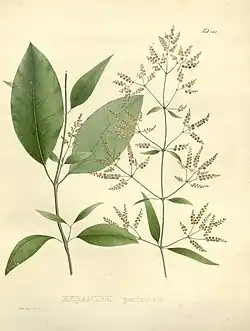Hebanthe erianthos
| Hebanthe erianthos | |
|---|---|

| |
| Scientific classification | |
| Kingdom: | Plantae |
| Clade: | Tracheophytes |
| Clade: | Angiosperms |
| Clade: | Eudicots |
| Order: | Caryophyllales |
| Family: | Amaranthaceae |
| Genus: | Hebanthe |
| Species: | H. erianthos
|
| Binomial name | |
| Hebanthe erianthos (Poir.) Pedersen
| |
| Synonyms[1] | |
| |
Hebanthe erianthos (many synonyms, including Iresine erianthos and Pfaffia paniculata),[1] known as suma or Brazilian ginseng, is a species of plant in the family Amaranthaceae. The specific epithet is also spelt "eriantha", although the basionym is Iresine erianthos.[2]
The root of this rambling ground vine found in South America is used traditionally as a medicine and tonic. Nicknamed "para tudo" in Brasil, which means "for everything", suma is a traditional herbal medicine.[3]
The root contains phytochemicals including saponins (pfaffosides).[4]
See also
References
- ^ a b "Hebanthe erianthos (Poir.) Pedersen". Plants of the World Online. Royal Botanic Gardens, Kew. Retrieved 2022-04-10.
- ^ "Hebanthe erianthe (Poir.) Pedersen". The International Plant Names Index. Retrieved 2022-04-10.
- ^ Vieira, Roberto F. (1999) Conservation of medicinal and aromatic plants in Brazil. p. 152–159. In: J. Janick (ed.), Perspectives on new crops and new uses. ASHS Press, Alexandria, VA.
- ^ "Triterpenoids from Brazilian Ginseng, Pfaffia paniculata" Jing Li, Atul N. Jadhav, Ikhlas A. Khan Tropical Plant Database Archived May 9, 2007, at the Wayback Machine